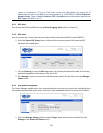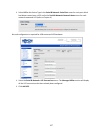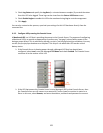
112
NUT can be configured using the Management Console as described above, or you can configure the
tools and manage the UPS’s directly from the command line. This section provides an overview of NUT.
You can find full documentation at http://www.networkupstools.org/doc
.
NUT is built on a networked model with a layered scheme of drivers, server and clients.
1. The driver programs talk directly to the UPS equipment and run on the same host as the NUT
network server upsd. Drivers are provided for a wide assortment of equipment from most of the
popular UPS vendors and they understand the specific language of each UPS and map it back to a
compatibility layer. This means both an expensive "smart" protocol UPS and a simple "power strip"
model can be handled transparently.
2. The NUT network server program upsd is responsible for passing status data from the drivers to the
client programs via the network. upsd can cache the status from multiple UPS’s and can then serve
this status data to many clients. upsd also contains access control features to limit the abilities of the
clients (so only authorized hosts may monitor or control the UPS hardware).
3. There are a number of NUT clients that connect to upsd to check on the status of the UPS hardware
and do things based on the status. These clients can run on the same host as the NUT server or they
can communicate with the NUT server over the network (enabling them to monitor any UPS
anywhere).
The upsmon client enables servers that draw power through the UPS (i.e. Slaves of the UPS) to
shutdown gracefully when the battery power reaches critical. Additionally, one server is designated
the Master of the UPS, and is responsible for shutting down the UPS itself when all Slaves have shut
down. Typically, the Master of the UPS is the one connected to the UPS via serial or USB cable.
upsmon can monitor multiple UPS’s, so high-end servers which receive power from multiple UPS’s
simultaneously won't initiate a shutdown until the total power situation across all source UPS’s
becomes critical.
There also the two status/logging clients, upsc and upslog. The upsc client provides a quick way to
poll the status of a UPS. It can be used inside shell scripts and other programs that need UPS status
information. upslog is a background service that periodically polls the status of a UPS, writing it to a
file.
All these clients run on the Console Server (for Management Console presentations) but they also
are run remotely (on locally powered servers and remote monitoring systems).
This layered NUT architecture enables:
Multiple architecture support: NUT can manage serial and USB-connected models with the same
common interface. SNMP equipment can also be monitored (although at this stage this is still pre-
release with experimental drivers and this feature will be added to the embedded UPS tools in future
release).
Multiple clients monitoring one UPS: Multiple systems may monitor a single UPS using only their
network connections. There’s a wide selection of client programs which support monitoring UPS
hardware via NUT (Big Sister, Cacti, Nagios, Windows and more). Refer to
www.networkupstools.org/client-projects
.)


















